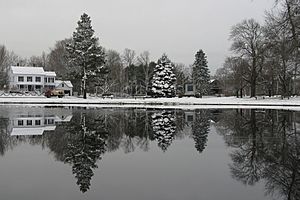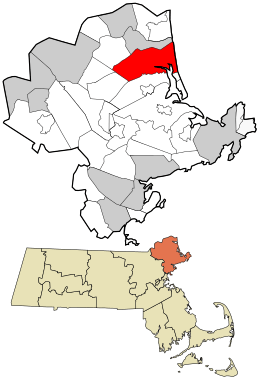Newbury, Massachusetts facts for kids
Quick facts for kids
Newbury, Massachusetts
|
|||
|---|---|---|---|
 |
|||
|
|||

Location in Essex County and the state of Massachusetts.
|
|||
| Country | United States | ||
| State | Massachusetts | ||
| County | Essex | ||
| Settled | 1635 | ||
| Incorporated | May 6, 1635 | ||
| Government | |||
| • Type | Open town meeting | ||
| Area | |||
| • Total | 26.3 sq mi (68.1 km2) | ||
| • Land | 23.4 sq mi (60.5 km2) | ||
| • Water | 2.9 sq mi (7.6 km2) | ||
| Elevation | 37 ft (11 m) | ||
| Population
(2020)
|
|||
| • Total | 6,716 | ||
| • Density | 255.42/sq mi (98.62/km2) | ||
| Time zone | UTC-5 (Eastern) | ||
| • Summer (DST) | UTC-4 (Eastern) | ||
| ZIP code |
01951
|
||
| Area code(s) | 351 / 978 | ||
| FIPS code | 25-45175 | ||
| GNIS feature ID | 0619452 | ||
Newbury is a town in Essex County, Massachusetts, United States. It's a classic New England community. In 2020, about 6,716 people lived here. Newbury includes smaller areas called villages: Old Town (also known as Newbury Center), Plum Island, and Byfield. Each of these villages has its own voting area and local offices.
Contents
History of Newbury
Early Inhabitants and Settlement
Long before Europeans arrived, Native American tribes lived along the Merrimack River for thousands of years. When the first Europeans came, the Pennacook tribe lived north of the river. The Agawam and Naumkeag tribes lived to the southeast and southwest.
The area that became Newbury was possibly called Quascancunquen by the Native Americans. This word means "waterfall." It likely referred to the falls in Byfield on the Parker River. This land was probably part of the territory of Masconomet, an Agawam leader.
English colonists settled and officially formed Newbury Plantation in 1635. A group of about 100 pioneers came from Wiltshire, England. They were led by Rev. Thomas Parker and his cousin Rev. James Noyes. They sailed on a ship called the Mary and John. They first landed in Agawam (now Ipswich) in 1634. The next spring, they arrived at the Quascacunquen River, which is now the Parker River. A special stone marks the spot where Nicholas Noyes was the first settler to step ashore. The town was named after Newbury, Berkshire, a town in England.
Land Purchases and Growth
In 1650, the town of Newbury bought 30 acres of land, now part of West Newbury, from a Native American man named Great Tom. They paid three pounds for it. Later, in 1681, the family of another Native American man, Old Will, sold 160 acres to Newbury for six pounds, thirteen shillings, and four pence. Finally, in 1700, the grandson of Chief Masconomet gave up his claim to any lands in Newbury for ten pounds.
By 1791, Newbury was a farming community. About 3,000 cattle grazed on the town's lands. People also worked in tanning (making leather) and shipbuilding. Newbury was originally much larger. The town of Newburyport became a separate town in 1764. West Newbury also became its own town in 1819.
Industry and Education
In 1636, the first water-powered mill was built at the falls. These mills were used for grinding grain (gristmills) and cutting wood (sawmills). In 1794, the first textile mill in Massachusetts was built here.
Byfield became an important mill village. It once had six water-powered mills that made things like wool clothes and snuff. In 1763, the nation's first boarding preparatory school was founded in Byfield. It was called Dum'r Charity School, and is now known as The Governor's Academy. In 1807, the first school for girls (female seminary) was also founded here.
Later Developments
The railroad came to Newbury in 1850. It carried goods and also brought tourists. This helped Plum Island become a popular seaside resort with Victorian buildings.
In 1878, silver was found in a large field on the mainland. The Chipman Silver Mine started operating but closed in 1925. By 1905, Newbury's economy had mostly returned to farming. The town supplied eggs, milk, and poultry. Some people also dug for clams or harvested hay from the salt marshes. Today, Newbury is mainly a residential town. It has many beautiful old buildings.
Geography of Newbury
Newbury covers about 68.1 square kilometers (26.3 square miles). Most of this area, about 60.5 square kilometers (23.4 square miles), is land. The rest, about 7.6 square kilometers (2.9 square miles), is water.
Newbury is located just south of where the Merrimack River meets the ocean. The Little River and Parker River flow through the town. These rivers, along with the Plum Island River, flow into Plum Island Sound. This sound separates Plum Island from the mainland. A lot of Newbury's land is made up of marshes. Much of this marshland is protected. It is part of the Parker River National Wildlife Refuge and other wildlife areas.
Newbury is on the Atlantic Ocean. It borders Newburyport to the north and West Newbury to the northwest. It also borders a small part of Groveland to the west, Georgetown to the southwest, and Rowley to the south.
Newbury is about 32 miles (51 km) north-northeast of Boston. Interstate 95 goes through the western part of town. U.S. Route 1 (also called the Newburyport Turnpike) runs north to south through the middle of town. Massachusetts Route 1A is in the eastern part of town, near the marshes.
The town has a small private airport called Plum Island Airport. For bigger flights, the closest major airport is Logan International Airport in Boston. The Newburyport/Rockport Line of the MBTA Commuter Rail train passes through Newbury. Its last stop is just over the line in Newburyport.
Population Information
| Historical population | ||
|---|---|---|
| Year | Pop. | ±% |
| 1790 | 3,972 | — |
| 1800 | 4,076 | +2.6% |
| 1810 | 5,176 | +27.0% |
| 1820 | 3,671 | −29.1% |
| 1830 | 3,603 | −1.9% |
| 1840 | 3,789 | +5.2% |
| 1850 | 4,426 | +16.8% |
| 1860 | 1,444 | −67.4% |
| 1870 | 1,430 | −1.0% |
| 1880 | 1,566 | +9.5% |
| 1890 | 1,427 | −8.9% |
| 1900 | 1,601 | +12.2% |
| 1910 | 1,482 | −7.4% |
| 1920 | 1,303 | −12.1% |
| 1930 | 1,530 | +17.4% |
| 1940 | 1,599 | +4.5% |
| 1950 | 1,994 | +24.7% |
| 1960 | 2,519 | +26.3% |
| 1970 | 3,804 | +51.0% |
| 1980 | 4,529 | +19.1% |
| 1990 | 5,623 | +24.2% |
| 2000 | 6,717 | +19.5% |
| 2010 | 6,666 | −0.8% |
| 2020 | 6,716 | +0.8% |
| 2022* | 6,695 | −0.3% |
| * = population estimate. Source: United States Census records and Population Estimates Program data. |
||
In 2000, there were 6,717 people living in Newbury. The population was spread out, with about 27% of residents being under 18 years old. The median age was 40 years. This means half the people were younger than 40 and half were older.
Education
Newbury has one public elementary school, Newbury Elementary School, which teaches students from kindergarten through 6th grade. After elementary school, students go to Triton Regional Middle School for 7th and 8th grades. For high school, students attend Triton Regional High School for grades 9 through 12. Students from Rowley and Salisbury also attend these Triton schools. Newbury is also part of the Whittier Regional Vocational Technical High School district, which offers vocational training.
Points of Interest
Newbury has several interesting historical places to visit:
- Coffin House (built around 1678)
- Dole-Little House (built around 1715)
- James Noyes House (built around 1646)
- Spencer-Peirce-Little Farm (built around 1690)
- Swett-Ilsley House (built around 1670)
- Abraham Adams House
- The Governor's Academy (formerly Governor Dummer Academy), a private preparatory school in Byfield.
- Parker River National Wildlife Refuge (also partly in Rowley and Ipswich)
Notable People
Many interesting people have connections to Newbury:
- Joshua Coffin: An American expert on old things and someone who worked to end slavery.
- Andre Dubus III (born 1959): A well-known author.
- Richard Dummer: An early settler who arrived in Newbury in 1635.
- William Dummer: He was the Lieutenant Governor of the Massachusetts Bay Colony.
- Jonathan Singletary Dunham: An important early American settler in Woodbridge Township, New Jersey.
- Moses Little: A colonel in the 12th Continental Regiment during the American Revolution.
- William Henry Moody: He became a Justice on the United States Supreme Court and was also the United States Attorney General. He helped with the trial of Lizzie Borden.
- Samuel Moore: Settled in Newbury in 1634, then moved to Woodbridge, New Jersey, where he held many important jobs.
- Theophilus Parsons: He was the Chief Justice of the Massachusetts Supreme Judicial Court.
- Eliphalet Pearson: The first Principal of Phillips Academy (from 1778–1786) and also the Acting President of Harvard University (from 1804–1806).
- John Woodbridge: Settled in Newbury in 1634. He was the Town Clerk of Newbury and a representative to the General Court.
Images for kids
See also
 In Spanish: Newbury (Massachusetts) para niños
In Spanish: Newbury (Massachusetts) para niños





